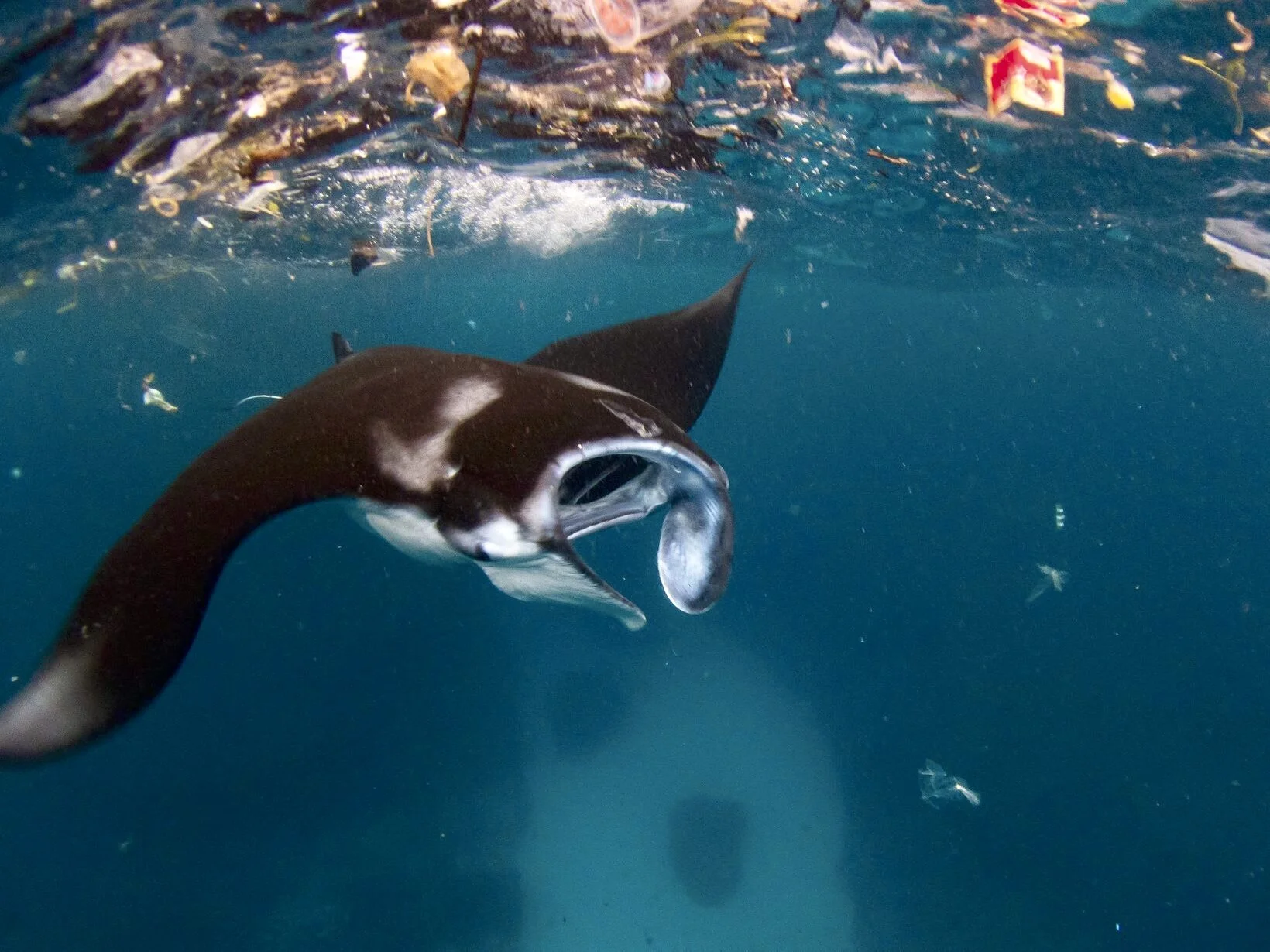Microplastics and Manta Rays: What’s In the Water?
A new study by Marine Megafauna Foundation (MMF) follows up on our previous investigations into plastics in manta ray feeding grounds to find out what types of plastics these animals are accidentally ingesting. With manta rays being large filter-feeders that can easily ingest plastics, this research is of critical importance. The research uses visual sorting and chemical analysis to identify which polymers (plastic’s building blocks) make up the material floating on the surface waters of Manta Bay in Indonesia. As each polymer type has different properties, understanding the kinds of plastics manta rays are consuming, and how toxic they are to them, will help assess the potential risks of plastic ingestion to these threatened species.
The study, published in Marine Pollution Bulletin, tested a more cost-effective methodology combining visual and chemical analyses and found that visual inspection could adequately predict the chemical composition of seven out of 10 visually grouped plastics. The study reports that the majority of plastics were broken pieces of larger items. Most plastics were either transparent, white, blue, or green, colors that resemble plankton and other natural prey of planktivorous fish. The most common polymers were polyethylene, polypropylene, polystyrene (i.e., styrofoam), and polyester. Some of these plastics have known toxicological effects and can adsorb and leach other pollutants from the surrounding environment. The type of plastic can also influence which harmful microbes hitchhike onboard.
Plastics in marine environments vary in their physical and chemical properties, influencing their risk to ocean life once ingested. To assess this risk, we characterized the plastics in a critical feeding habitat off Nusa Penida, Indonesia by examining the color and polymer composition of small plastic samples (<30 mm). Our findings were that the plastics were mostly secondary microplastics and transparent (46%), white/off-white (24%), and blue/green (22%). Further analysis grouped the samples according to type (films, fragments, foam, or lines) and color indicated that 99% were polyethylene (PE) or polypropylene (PP), with the remainder being polystyrene and polyester. Visual characterization aligned with single polymer composition in seven out of ten groups. Although PE and PP have relatively low toxicity compared to other plastics, their composing monomers and associated pollutants and microbes are of concern to manta rays and other marine biota.
Janis Argeswara, project leader with MMF and lead author of the study, states, “plastics are not created equal. We knew that a variety of plastics were floating around manta ray feeding grounds and being consumed by feeding manta rays. To understand the potential damage that these plastics might cause, we need to know what these plastics are made of, especially small-sized plastics, or microplastics.”
Dr. Elitza Germanov, an MMF Senior Scientist and co-author of the study, says, “confirming polymer types of microplastics helps identify their origin, which is important for directing mitigation efforts. The overwhelming majority of plastics in these critical habitats are made of polymers commonly used in packaging materials and household items. Thus, improved waste management will need to go hand-in-hand with extending the responsibility of producers to reduce the amount of single-use plastics and packaging materials released into local consumer markets.”
In 2015, Indonesia was ranked as the second-worst marine plastic pollution producer globally and is hoping to substantially limit its plastic pollution problem by 2025. Several plastic mitigation efforts have been put in place in the last few years, including regional bans on plastic bags and the most commonly used consumer single-use plastics. However, plastic that has already entered the marine environment will persist for decades and continue to enter food webs, posing long-term implications to threatened marine species, such as manta rays.
This research was supported by Ocean Park Conservation Foundation, Mantahari Oceancare, Idea Wild, Foundation Fortuna, PADI Foundation, Divine Diving, Scuba Junkie Komodo, Scuba Junkie Penida, and World Diving Lembongan, Blue Corner Dive, Big Fish Diving, Yoga Shack, J. Fischer, R. Horner, members from the Marine Megafauna Foundation, especially L. Ellevog, L. Auditore, G. Barford, and S. Kalucza, Captains Edy and Tony, C. Parfitt and R. Horner (microscopy tools and assistance), the Chemical Engineering Lab, Universitas Indonesia (FTIR analysis), IGN Putra Dirgayusa, Ni Luh Putu Ria Puspitha, and I Nyoman Giri Putra (academic input).
Click here to read the full study published in Marine Pollution Bulletin.
Notes to Editors
For questions about this press release, please contact:
Janis Argeswara, Marine Megafauna Foundation
Email: janis.argeswara@marinemegafauna.org
Dr. Elitza Germanov, Marine Megafauna Foundation
Email: elitza.germanov@marinemegafauna.org
The Marine Megafauna Foundation (MMF) was created in 2009 to research, protect, and conserve the populations of threatened marine megafauna around the world. MMF’s headquarters are located in Tofo, Mozambique, where they operate as Associação Megafauna Marinha (AMM). ‘Megafauna’ are large marine species such as sharks, rays, and sea turtles. For further details, please see www.marinemegafauna.org or follow us on Twitter, Facebook, Instagram, and LinkedIn.












